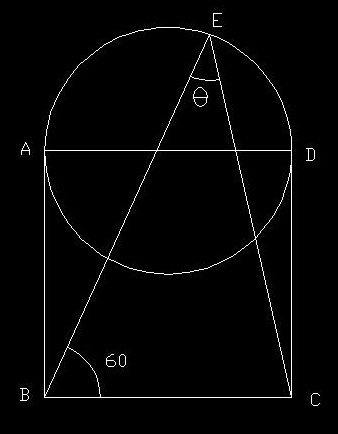HELP: what is value of the angle?
Hello, I want to find the angle accurately. Please help me out.

ABCD is a square and AD is the diameter of the circle. what is the value of ?
I think is independent of the length of the sides of the square and am getting an answer approximately 40.183 degrees. I got the answer by solving some properties of triangle equations and doing some constructions. I don't know whether it is right or wrong. My question is what is the exact angle? And can we get the angle by means of constructions only (I mean without using a calculator because in my case I needed to calculate huge surds:-\ )?
Thanks in advance.
No vote yet
1 vote
Easy Math Editor
This discussion board is a place to discuss our Daily Challenges and the math and science related to those challenges. Explanations are more than just a solution — they should explain the steps and thinking strategies that you used to obtain the solution. Comments should further the discussion of math and science.
When posting on Brilliant:
*italics*or_italics_**bold**or__bold__paragraph 1
paragraph 2
[example link](https://brilliant.org)> This is a quote# I indented these lines # 4 spaces, and now they show # up as a code block. print "hello world"\(...\)or\[...\]to ensure proper formatting.2 \times 32^{34}a_{i-1}\frac{2}{3}\sqrt{2}\sum_{i=1}^3\sin \theta\boxed{123}Comments
Suppose the side length of the square is 1. The circle equation is:
(x−21)2+(y−1)2=41
Suppose point B is the origin. Define a direction vector:
vx=cos60∘vy=sin60∘
Substitute into the circle equation:
(αvx−21)2+(αvy−1)2=41
The remaining steps are:
1) Expand to get a quadratic equation in α
2) Solve for α. Note that you must solve for the greater alpha value
3) (Ex,Ey)=(αvx,αvy)
4) Calculate vectors from E to B and E to C
5) Given those two vectors, use the dot product formula to calculate θ. In other words, take the arc-cosine of a quantity equal to the dot product divided by the product of the vector magnitudes.
This yields θ=37.9235∘
Log in to reply
Taking B as the origin is really clever
Nice solution! I did a mistake in the calculation. The equations were really messy. I am also getting 37.9 degree. Thank you so much!!!!
I got approximately 37.9235°, but I'm really not sure because the exact formulas get really messy.
First, I put the construction into a coordinate system with the center of the circle at the origin and 1 unit as the radiua of the circle. Every point on this circle can be written as (cosα,sinα), where α is the central angle.
Then I considered the slope of line DE. It is given as 60∘=3, but we can also write it as ΔxΔy=cosα+1sinα+2. If we set these two equal to each other, we can solve for α and get α=2arctan(−21+3−43).
Now we can plug this into E=(cosα,sinα) and get E=(−43+213−43,−21+413+213−49).
Then we can calculate the slope of line EC as −7+23+43−36+3+123−9.
If we take the inverse tangent of this we get the angle at C which we subtract from 180∘−60∘ to get our final answer of 32π+arctan(−49−3−21481+123)≈37.9235∘.
As I said, it gets really complicated and I'm not sure if I've calculated it correctly but I think the way I did it is right.
Log in to reply
I got the same answer. My solution is above